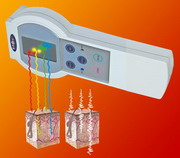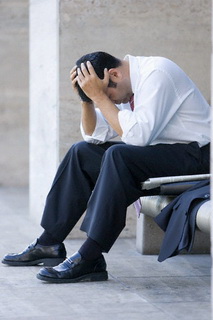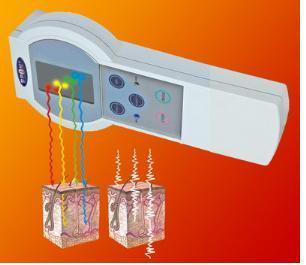Novelties
"PhotoSPOK"

A new-generation physio-
therapeutic apparatus which
is practically an effective combination of several physiotherapeutic apparatuses in one.
The apparatus is portable, easy-to-use, safe and secure.
|
AndroSPOK: Prostatitis
 Prostatitis is inflammation of the prostate gland which is the most frequent disorder of the male
genital organs. Usually, prostatitis affects men at the age of 30-50 years. Prostatitis may be acute and chronic, infectious and noninfectious.
Irrespective of the prostatitis type, the hyperemia of the venous plexus of a small pelvis and a prostate gland itself (constipations, sedentary life-style, lengthy sexual abstinence or sexual excess, hypothermia and alcoholism) underlie the prostatitis etiology. The prostate gland has no its own great vessels and the blood is supplied through small vessels from eight-ten sources. Therefore, the blood flow velocity in the prostate gland is initially low which, in its turn, prone both to infections and to stagnation (congestion)-induced changes in the prostate gland tissue. These factors mainly define complexity of structural changes of the prostate gland and multiplicity of the prostatitis clinical forms. Prostatitis is inflammation of the prostate gland which is the most frequent disorder of the male
genital organs. Usually, prostatitis affects men at the age of 30-50 years. Prostatitis may be acute and chronic, infectious and noninfectious.
Irrespective of the prostatitis type, the hyperemia of the venous plexus of a small pelvis and a prostate gland itself (constipations, sedentary life-style, lengthy sexual abstinence or sexual excess, hypothermia and alcoholism) underlie the prostatitis etiology. The prostate gland has no its own great vessels and the blood is supplied through small vessels from eight-ten sources. Therefore, the blood flow velocity in the prostate gland is initially low which, in its turn, prone both to infections and to stagnation (congestion)-induced changes in the prostate gland tissue. These factors mainly define complexity of structural changes of the prostate gland and multiplicity of the prostatitis clinical forms.
Prostatitis Classification
I. Acute prostatitis. It is always characterized by the infectious etiology.
II. Chronic infectious prostatitis. It accounts for 5-10% of chronic prostatitis cases. Clinical symptoms и prostatitis laboratory signs, presence of a causative agent of infection.
III. Chronic noninfectious prostatitis (or chronic pelvic pain syndrome). It accounts for 90% of chronic prostatitis cases. Prostatitis clinical symptoms, negative results of bacteriological tests. The prostatitis is classified into 2 types subject to laboratory signs:
type A — characterized by increased white blood cell count in the prostate gland secretion (inflammatory syndrome).
type B — characterized by normal white blood cell count in the prostate gland secretion (non-inflammatory syndrome).
IV. Asymptomatic inflammatory prostatitis. Since clinical symptoms of prostatitis are not available, it is detected incidentally during examination in diagnosing other diseases; incidence is not known.
As a rule, the following people are affected by prostatitis:
1) living a sedentary way of life;
2) engaged in “sedentary” activity;
3) suffering from chronic constipations;
4) suffered from urogenital system infection;
5) having casual sex;
Prostatitis symptoms:
The first symptom — minor voiding difficulty (dysuria). The inflamed prostate gland increases in volume and squeezes the urethra. Gradually, the progressing inflammatory process results in sclerosis of a neck of the urinary bladder. As a rule, dysuria resides in frequent desires to urinate and feeling of incomplete bladder emptying. More frequent urination and voiding difficulty are expressed at the early prostatitis stage and then somewhat subside since the organism produces adaptation mechanisms. But as the disease progresses, dysuria progresses as well.
The second symptom — sexual disorder. Erection is impaired and orgasm weakens. At later (advanced) disease stages, the prostatitis results in an erectile dysfunction (impotence). As a rule, at early disease stages, men develop dispotence — reduced potency accompanied by qualitative disorders. The erection may be impaired, while other men may have frequent nocturnal penile tumescence. The chronic prostatitis is almost always accompanied by prospermia and the so-called obliterated orgasm. Frequently, pains occur during ejaculation and after orgasm and as a result a patient avoids sexual life.
The third symptom — painful sensation and discomfort in the perinea and scrotum region. As a rule, the prostatitis-related pains are radiating pains shooting up the sacrum, perinea and specifically scrotum. The prostate gland itself actually does not “ache”, however, nerve tracks extend from it to all small pelvis organs — that is why pains frequently shoot up the lower back. In terms of intensity, the pains range from aching pains to sharp sleep-disturbing pains. Pains may increase or decrease during the sexual abstinence or vice a versa during the excessive sexual activity, after discharge and during ejaculation.
In addition, the prostatitis manifestations may include:
1) burning sensation in urethra;
2) discomfort during defecation;
3) frequent urination and urinary urgency;
4) difficult and stuttering urination;
5) pilimiction;
6) reduced potency;
7) lengthy nocturnal penile tumescence;
8) premature ejaculation (prospermia);
9) obliterated orgasm;
10) acrimony and anxiety.
Prostatitis Treatment
Complete and guaranteed treatment of the chronic prostatitis is not possible. The prostatitis is the disease so complex and insidious that it poses a big problem for the doctors to treat it. Frequently, only remission may be achieved. The majority of chronic prostatitis treatment regimens includes antibacterial drugs and phytopreparations producing effect on the prostate gland, drugs improving blood circulation and anti-inflammatory therapy. An attending doctor is an “ultimate authority” to decide which regimen to choose. He/she particularly determines which treatment elements are needed with consideration for complaints and specifics of the disease progression.
Physiotherapy plays a crucial role in the prostatitis treatment. Among the modalities, the maximum effect is produced by the methods eliminating prostatic congestions and producing anti-inflammatory effect (magnetotherapy, light therapy and barotherapy). A combined application of the above physiotherapeutic methods produces high therapeutic effect.
A unique "AndroSPOK" polyfactor apparatus is a new-generation physiotherapeutic apparatus designed for the magnetophotobarotherapy, i.e. a combined exposure to light, magnetic field and topical negative pressure. The "AndroSPOK" magnetophotobarotherapy apparatus may be efficiently used for complex treatment and prevention of the chronic prostatitis.
10 Methods for Efficient Prostatitis Prevention
 1. Balanced diet. A diet rich in vitamins, minerals and fibers. Eat more vegetables and fruits. Avoid spicy food.
1. Balanced diet. A diet rich in vitamins, minerals and fibers. Eat more vegetables and fruits. Avoid spicy food.
2. Avoid hypothermia (sitting on cold objects).
3. Do not wear tight clothes. Abandon continuously wearing tight swimming trunks and briefs. Loose cotton underwear is much more hygienic and does not prevent normal blood circulation in the prostate gland.
4. Do not abuse alcohol; abandon smoking.
5. Normalize a sexual life. Living a regular sexual life without going to extremes guarantees health of the prostate gland. Never use the tactics of coitus interruptus.
6. Completely treat all pockets of chronic infection.
7. Avoid hypodynamia, do physical exercises. (10 minutes of physical exercises after 30 minutes of sitting).
8. Normalize stool– regular bowel evacuation prevents blood circulation disorders in a prostate gland.
9. Avoid casual sexual encounters. Sexually transmitted diseases are one of the most frequent causes to develop prostatitis.
10. An efficient prevention and treatment of chronic prostatitis and reduce potency using the AndroSPOK magnetophotobarotherapy apparatus. A unique development of physical scientists and medical biologists which has cardinally changed views on the therapy of a number of diseases of the men’s urogenital system.
"AndroSPOK" scope:
|
Device SPOK for
Home
"PhotoSPOK"

"AndroSPOK"

|